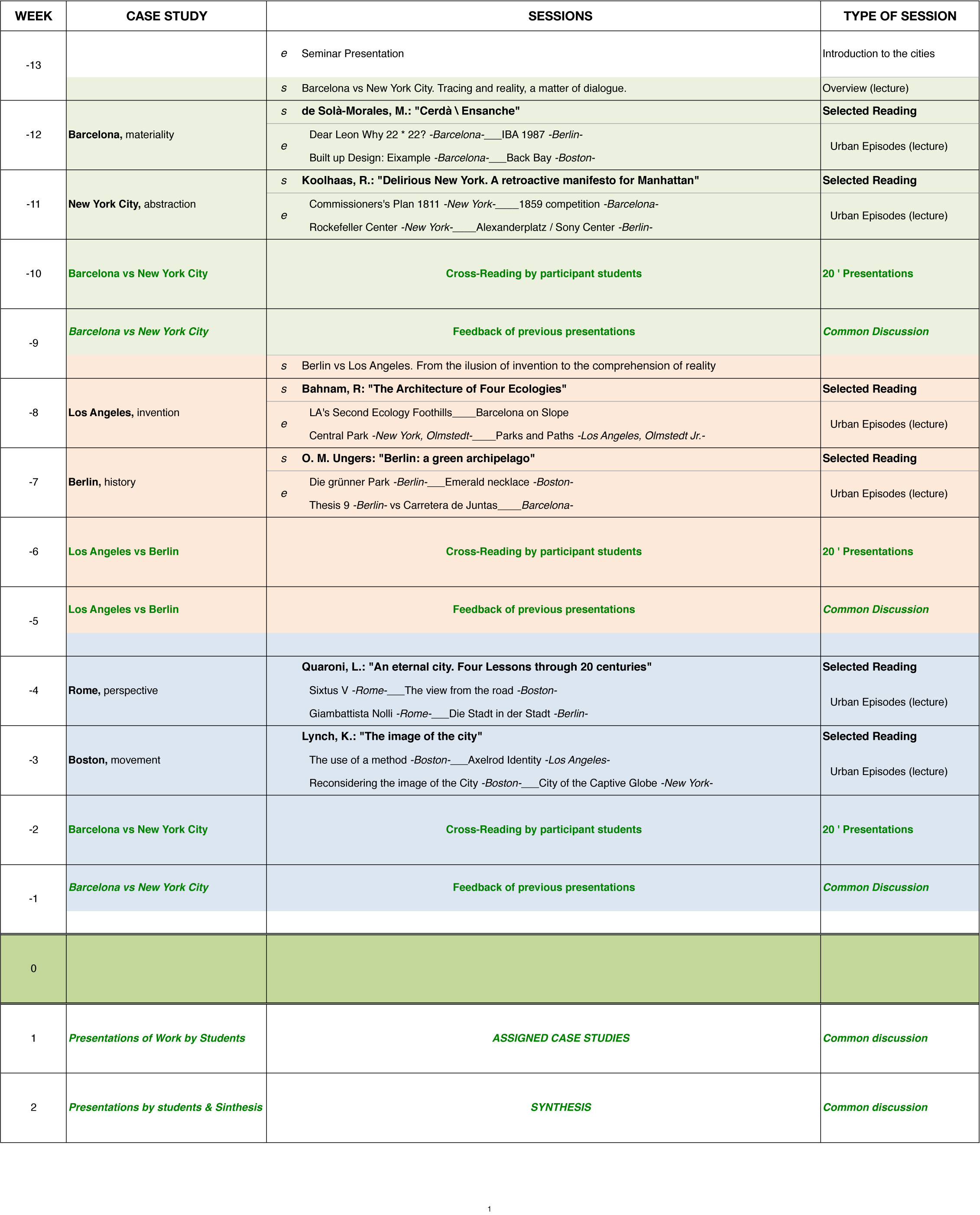Ciutats: pedra sobre paper / Cities: stone on paper
Qm Primavera 2015-2016
| Qm | Nivell Quadrimestral | Núm. màxim d'estudiants |
Idioma |
| P | 7-10 | 20 |
"English only. Native or proficient english (B2 according to MERC) to be proven upon registration to the seminar" |
| Codi | Crèdits | Distribució (T, P, L) | Departament | H/s treball estudiant |
| 290174 | 4 (3,5 ECTS) | 2T, 2L | UOT | 3 |
| Dia d'impartició | Hora d'impartició | Núm de setmanes |
| Dilluns/Monday | 15:30 - 18:40 | 12 |
| Professor Responsable | Adolf Sotoca |
| Altres professors |
Objectius
|
“Cities: stone on paper” tracta dels arquitectes que escriuen sobre les seves ciutats. Sis urbs exemplars (3 europees i 3 americanes) són el camp de treball a partir del qual els participants en el seminari obtindran una visió rica i global de l’aproximació arquitectònica a la ciutat. |
Objetivos
|
“Cities: stone on paper” trata de los arquitectos que escriben sobre sus ciudades. Seis urbes ejemplares (3 europeas y 3 americanas) son el campo de trabajo a partir del cual los participantes en el seminari obtendran una visión rica y global de la aproximació arquitectónica a la ciudad.
|
Subject abstract
|
"Cities: stone on paper" focuses on architects who write about their cities. A set of six remarkable case studies (3 European + 3 North American) constitutes the field from where the students will obtain a diverse and rich overview of the architectural approach to he city scale.
We will get to know them through six seminal books written by architects:
Barcelona: “Cerdà / Ensanche” by Manuel de Sola‐Morales.
New York City: “Delirious New York” by R. Koolhaas.
Los Angeles: “Los Angeles: the architecture of four ecologies” by R. Banham.
Berlin:“Berlin as a green archipelago” by O.M. Ungers.
Boston: “The Image of the City” articles by K. Lynch
Rome: “An eternal city. Four lessons of twenty-‐seven centuries” by L. Quaroni. |
Learning outcomes. At the end of the course the student should be able to:
| Generic required and trained competences. - Reading and understanding of text. - Capability for translating reflections into graphics. - Capability for synthesis of reflections in brief but meaningful texts. - Basic culture on urbanism through the analysis and reflection of paradigmatic case studies of western cities urban history. |
Content
|
|
Evaluation
|
All students will be required to prepare three mid-term presentations and one final research work: |
Bibliography
|
Axelrod, J (2009) “Inventing Autopia. Dreams and visionsof the modern metròpolis in jazz age Los Angeles”, University of California Press. Bacon, E. (1976) “Design of cities”, Penguin Books. Ballon, H. (2012) “The Greatest Grid. The Master Plan of Manhattan, 1811-2011”, The Museum of the City of New York. Banerjee, T.& Southworth M. (2002) “City Sense and City Design. Writings and projects of Kevin Lynch”, MIT Press Banham, R. (2000) “Los Angeles. The Architecture of four ecologies”, University of California Press. Hertweck, F.& Marot, S. (2013). “The City in the City. A manifesto (1977) by Oswald Mathias Ungers and Rem Koolhaas”, Lars Müller Publishers. Koolhaas, R. (1994) “Delirious New York. A retroactive manifesto for Manhattan”, Monacelli Press. Quaroni, L. (2008) “Una Ciudad eterna. Cuatro lecciones de veintisiete siglos. An eternal city. Four lessons of twenty-seven centuries”, Fundación Caja de Arquitectos. Sennet, R.(1992), “The conscience of the eye. The Design and Social Life of Cities”, W.W. Norton and Company. De Sola-Morales, M. (2008) “Ten Lessons on Barcelona”, COAC. De Sola-Morales, M. (2010) “Cerda--‐Ensanche”, Edicions UPC_BarcelonaTECH. |

Compartir: